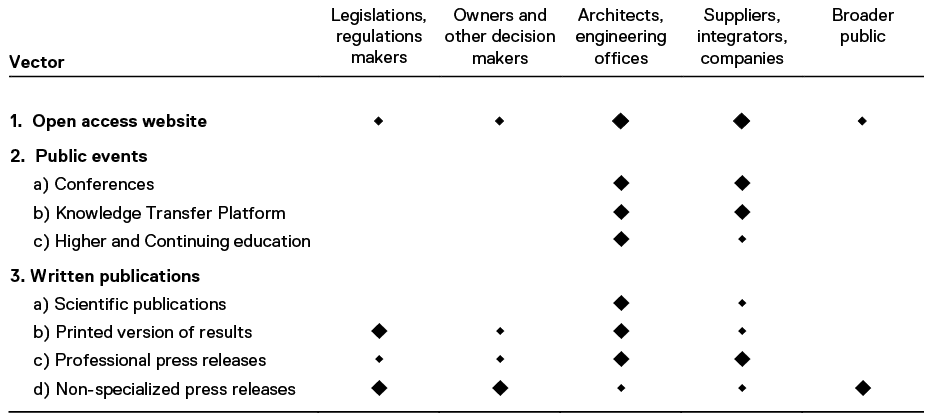How can we improve the knowledge and technology transfer?
BIPV technology suffers from a lack of visibility and knowledge among the broad public, but also among professionals in the construction field [1]. It is therefore important to raise awareness of the existence and feasibility of BIPV solutions, to create synergies between construction and BIPV stakeholders, and to train architects and engineers on the BIPV theme so they can advise their customers on this yet unknown technology.
Major stakeholders and communication vectors
The knowledge and technology transfer is targeted towards 6 major stakeholder groups:
- Legislation and regulation makers at federal, cantonal and communal level;
- Owners and other decision makers along the value chain;
- Architects, engineering offices;
- Suppliers, integrators, construction companies;
- Scientists and researchers in the concerned fields; and
- The broader public.
In order to optimize communication strategy impact, different types of communication vectors are activated for each group: open access website, public event and written publications (Fig. 1).

Regional public events & conferences
In the last few years, partners of the ACTIVE INTERFACES project have organized events with the aim of presenting research on new BIPV technologies, but also on BIPV architectural integration strategies and market studies:
- Abend der Wirtschaft 2014 Das solare Gebäude im System, Lucerne (LU), 2014
- Workshop Lifetime and Reliability issues in PV, Manno (TI), 2015
- 3ème Conférence Zéro Carbone, Fribourg (FR), 2015
- 17ème Forum Ecoparc, Neuchâtel (NE), 2017
- Workshop "Community Solar as a Business Opportunity for Municipal Utilities", St. Gallen (SG), 2018.
The progress of research work around BIPV is frequently presented at regional or national conferences, such as : National Photovoltaic Congress, Advanced Building Skin Conference, CISBAT Conference, Bau+Energie Messe and International Sustainable Built Environment (SBE) series Conference.



